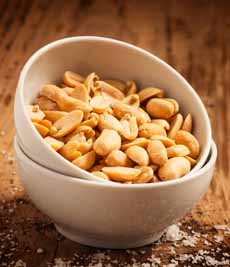FOOD 101: The History Of Peanuts For National Peanut Day
|
September 13th is National Peanut Day. January 24th is National Peanut Butter Day, and PB&J lovers can look forward to April 2nd. A bit of history about the peanut, also known as a groundnut and goober. First, it isn’t a nut, but a legume. The difference: A legume is a pod with multiple seeds. A nut has a hard outer shell protecting a single seed, the “nut.” You can drill down here. Along with the bean, cacao, cassava, chia, chile, corn, papaya, pineapple, potato and sweet potato, quinoa, squash, sunflower, tomatillo and tomatoes, peanuts originated in Latin America. According to the National Peanut Board, botanists believe that peanuts originated in Brazil or Peru. While there is no fossil record, we have a pottery record: Pottery in the shape of peanuts or jars decorated with peanut motifs date back as far as 3,500 years. The archaeological record also shows that as early as 1500 B.C.E., the Incas in Peru used peanuts as a sacrificial offering. They were entombed with mummies for the afterlife. Tribes in central Brazil made a beverage from ground peanuts and maize. Spanish and Portuguese explorers encountered peanuts in the 16th century; the Spanish in Mexico, the Portuguese in Brazil. They brought peanuts back to their home countries, and from there traders and explorers spread them to Asia and Africa. Peanuts came to North America in the 1700s via Africa, where they had been introduced by Portuguese traders. But it wasn’t until the early 1800s that peanuts were grown in the U.S. as a commercial crop, first in Virginia, where they were used mainly for oil and as a food for livestock and the poor. Peanuts were eaten by Civil War soldiers as a protein-rich subsistence food. The Southern folk song “Goober Peas” was sung by Confederate soldiers (here’s a version sung by Burl Ives and Johnny Cash). After the war, Union soldiers brought them north. |
 Ready for snacking and garnishing (photo © PB Crave).
|
|
|
Peanut popularity grew in the late 1800s thanks to P.T. Barnum, whose circus wagons traveled across the country selling “hot roasted peanuts” to the crowds. Soon street vendors and then ballpark vendors began selling them. Around 1900, labor-saving equipment was invented for planting, cultivating, harvesting and picking the peanuts, then shelling and cleaning the kernels. With an abundance of supply, demand grew and their use expanded, especially for oil, roasted and salted nuts, peanut butter and candy (source). And you get to enjoy them!
|
||



